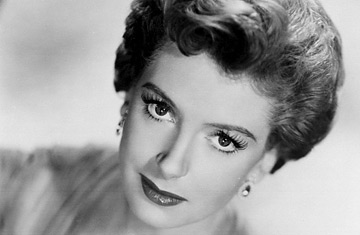
British actress Deborah Kerr, star of From Here To Eternity and The King And I, seen in this 1954 file photo, has died at the age of 86.
We remember movie actors of the 50s as an assembly of damaged brutes (starting with Brando) and buxom babes (mainly Monroe). But that was just part of the cosmology. They had ladies then, actresses who, in their fine features and perfect poise, their manner and manners, suggested that the old aristocracy was not ready to be overthrown. They could play women of nobility or ordinary girls with a sense of breeding. Often they came to Hollywood from English theater and films, but to many American viewers they seemed visitors from a higher realm. Their names still say "class": Vivien Leigh, Wendy Hiller, Jean Simmons, Claire Bloom. Of course, in a class by herself, Audrey Hepburn. And Deborah Kerr, whose grounded grace illuminated some of the best relics from the 40s and 50s, and who died Tuesday at 86.
How ladylike was Kerr (pronounced "car")? Three times the New York Film Critics' Circle named her best actress prize, and two of those awards came for playing nuns, in Black Narcissus in 1947 and Heaven Knows, Mr. Allison a decade later. (The third was as the wife of sheepherder Robert Mitchum in the 1960 The Sundowners.) How congenial? In 1956 she was given a Hollywood bauble called the Golden Apple Award as Most Cooperative Actress.
Most cooperative and most respected: she was an Academy Award finalist six times in a dozen years, earning Oscar nominations for Edward, My Son; From Here to Eternity; The King and I; Heaven Knows, Mr. Allison; Separate Tables and The Sundowners. But Kerr never took home a competitive statuette. In 1994, the Academy voted her a lifetime achievement award, proclaiming her "an artist of impeccable grace and beauty, a dedicated actress whose motion picture career has always stood for perfection, discipline and elegance."
That tribute, like my opening paragraph, betrays a nostalgia for a kinder, gentler moviescape, back when stars spoke love in whispered metaphors and a leading lady knew how to get out of a limo without exposing her crotch. But that notion of refinement was a fiction too. It happened to be the prevailing tone of A-list movies of the 40s that lingered through the 50s. Kerr was not some elevated being who allowed herself to be photographed. She was an actress, convincingly playing these roles. And though her career was never marked by scandal, off-camera she could be as earthy as the next mid-century star. "People always think I'm the epitome of the English gentlewoman," she told the Chicago Tribune after she retired, "which just goes to show that things are never quite what they seem."
Born in Scotland in 1921, the daughter of an architect who rose to Captain (and was wounded) in World War I, Deborah Jane Kerr Trimmer was a shy child who communicated through family theatricals. She studied dance and won a scholarship to the Sadler's Wells school, making her London debut in the corps de ballet of Prometheus.
The first film in which she appeared was the 1941 Major Barbara; she played a winsome Salvation Army lass under the tutelage of Hiller, the fresh-faced rage of the day. Kerr's radiance was both more demure and more alluring; and when pregnancy forced Hiller to drop out of Michael Powell and Emeric Pressburger's war epic The Life and Death of Colonel Blimp, Powell cast Kerr as the three women who, over a 40-year span, weave a romantic spell over the lead character. And over the co-director: Powell fell in love with her. During the shoot, on her 21st birthday, Powell proposed marriage. (They never wed.) In 1947, the Powell-Pressburger Black Narcissus brought Kerr to Hollywood's attention, and she was signed by MGM, where she quickly earned her first Oscar nomination as Spencer Tracy's alcoholic wife in Edward, My Son.
